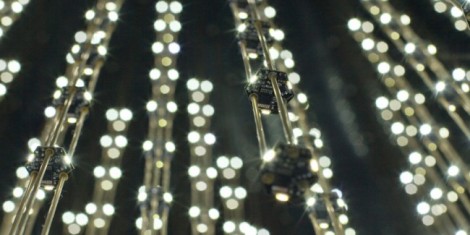
What has 9000 LEDs, 3000 MSP430 processors, six XMOS XC-2 Ethernet modules, and goes blinkity-blink-blink? It’s Swarm Light, an art installation shown at this year’s Art Basel exhibition. [Fredrik Petrini] worked on the hardware that went into building the group of three 3D cubes of LED light modules. Unlike so many art pieces we see he shared the design details of the piece. In the image above you can tell that each cube encompasses several rods of LED modules. Each rod as three rails that provide power, ground, and serial data in addition to serving as the physical structure. Each module has three LEDs on it controlled by one MSP430 processor. The XMOS units each control half of the rods in a cube, getting their instructions over an Ethernet connection from a PC running a program on a .NET framework. It would be an understatement to say this is just a upscaled LED cube. Check out the exhibit in action after the break. It uses an algorithm to analyze the music, taking input from the ambient sound in the room, to control the light fluctuation.
















